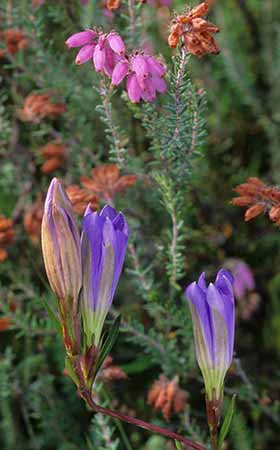Marsh gentian (Gentiana pneumonanthe)
When: August - September
How many: Quite small numbers and thinly distributed

with cross-leaved heath
Often tucked away amongst the crowded fronds of cross-leaved heath in transitional areas between heath and mire, it’s always a treat to find the bright blue, trumpet-shaped flowers of the marsh gentian carried proudly aloft on their upright, un-branched stems.
Today in much of Britain, marsh gentians are incredibly rare plants that have significantly declined in recent years as a result of wetland drainage, climate change and, scandalously, collecting.
But thankfully, strong marsh gentian populations survive in the New Forest where regular grazing by commoners’ stock, and deer helps to reduce competition from more vigorous plants that would otherwise crowd-out marsh gentians. Rotational, controlled burning has the same effect, and also produces areas of bare ground where marsh gentian seeds can better germinate.
Even in the New Forest, though, marsh gentian colonies are quite local, and at some, flowering is erratic from year-to-year.
The marsh gentian, or bog gentian as once it was known in the New Forest, grows to a height of 10-30 centimetres (4-12 inches), and blooms quite late in the year, gracing damp ground with startling vivid splashes of blue, and contrasting markedly with the pinks and purples of heath and heather.
The herbalist John Gerard noted of the marsh gentian in the late 16th century that: ‘The gallant flowers hereof bee in their bravery about the end of August’. He mentioned also that the root was useful against: ‘pestilent diseases’, and also, as with heather, to combat ‘bitings and stingings of venomous beasts’.
In more recent times, marsh gentian root extracts have been used to produce what apparently were very effective digestive tonics.
References:
The Flora of Hampshire: Anne Brewis, Paul Bowman and Francis Rose
The New Forest – A Natural History: Colin R. Tubbs
Reader’s Digest Field Guide to the Wild Flowers of Britain
The Herball or General Historie of Plantes: John Gerard
More links
Other related links
Search this site

Sadly, 58 animals were killed - 35 ponies, 13 cows, 8 donkeys and 2 sheep, whilst a further 32 were injured - 3 pigs, 9 donkeys, 11 cows and 9 ponies.
(Forty-three accidents occurred in daylight, 15 at twilight and 101 in the dark. Twenty-seven accidents were not reported by the driver involved).
Here's just one horrific example - Three donkeys killed in collision with van at notorious New Forest blackspot (Advertiser and Times)

